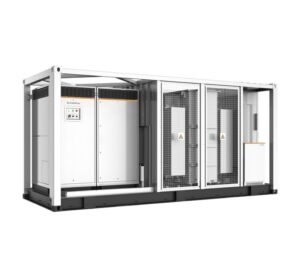Installing photovoltaic (PV) hybrid inverters in coastal areas comes with unique challenges. The harsh seaside environment, characterized by high salt content, humidity, and potentially corrosive elements, can significantly impact the longevity and functionality of solar power systems. In this blog, we’ll discuss key precautions to consider when installing PV hybrid inverters at the seaside and introduce the robust Sungrow SC series inverters, which are specifically designed to thrive in such demanding conditions.

Precautions for Installing PV Hybrid Inverters at the Seaside
- Corrosion Resistance
The presence of salt in the air near coastal areas can lead to accelerated corrosion of metal components and other materials commonly used in inverter construction. Choosing inverters with a high anti-corrosion rating is essential to prevent rapid degradation. Look for inverters with a C5 anti-corrosion degree, which indicates that the device can withstand harsh, salty environments.
- Protection from Moisture and Salt Mist
In addition to corrosion-resistant materials, it’s crucial that the inverter is well-sealed against moisture and salt mist. This protection helps prevent short circuits and other electrical failures caused by moisture ingress. Ensure that the inverter casing is robust and adheres to high protection standards, such as IP65, for outdoor use.
- Stable Mounting and Installation
High winds and storms are common in coastal areas, so it’s important to ensure that inverters are securely mounted with hardware that is also resistant to corrosion. Utilizing stainless steel or similarly durable materials for mounting brackets and hardware can help mitigate the risk of mechanical failure due to rust and decay.
- Cooling and Ventilation
Coastal locations can experience a range of temperatures, and the salty air can impact the efficiency of traditional cooling methods. It’s important to ensure that the inverter’s cooling system is designed to operate effectively in such conditions, potentially incorporating advanced cooling technologies that minimize the entry of corrosive particles.
Introducing Sungrow’s SC Series Inverters for Coastal Installations
Sungrow‘s SC series, including models SC2750UD-MV, SC3150UD-MV, SC3450UD-MV, SC4000UD-MV, and SC5000UD-MV, are exceptionally suited for environments close to the sea, thanks to their thoughtful design and robust features:
Optional C5 Anti-Corrosion Degree
The optional C5 anti-corrosion degree makes these inverters ideal for seaside installations. This high level of corrosion resistance ensures that Sungrow inverters can endure the corrosive effects of salt air, extending their operational lifespan and maintaining performance integrity.
Modular Design
The modular design of the SC series inverters simplifies maintenance and repair tasks. Each module can be individually replaced or serviced, reducing downtime and making it easier to manage the system without needing complete disassembly. This feature is particularly valuable in remote or challenging environments like coastal areas, where minimizing maintenance complexity is crucial.
Wide DC Voltage Operation Window
Operating with a wide DC voltage window and capable of full power at 1500 V, these inverters ensure that the solar system operates efficiently, even under the variable solar irradiance typical of coastal weather patterns. The high voltage operation reduces cable losses and increases the overall system efficiency, making it more cost-effective.
Conclusion
When installing PV hybrid inverters at seaside locations, it is crucial to consider factors such as corrosion resistance, moisture and salt mist protection, stable mounting, and effective cooling. Sungrow’s SC series inverters are designed with these challenges in mind, offering a robust solution that combines high corrosion resistance, ease of maintenance, and efficient operation. By selecting the right equipment and considering the unique environmental challenges, you can ensure a durable, efficient, and reliable solar energy system for coastal applications.










